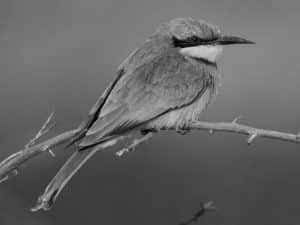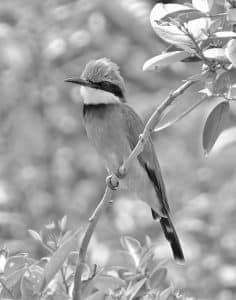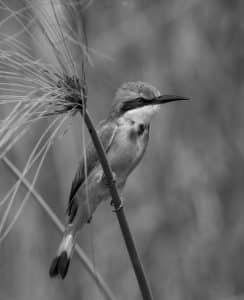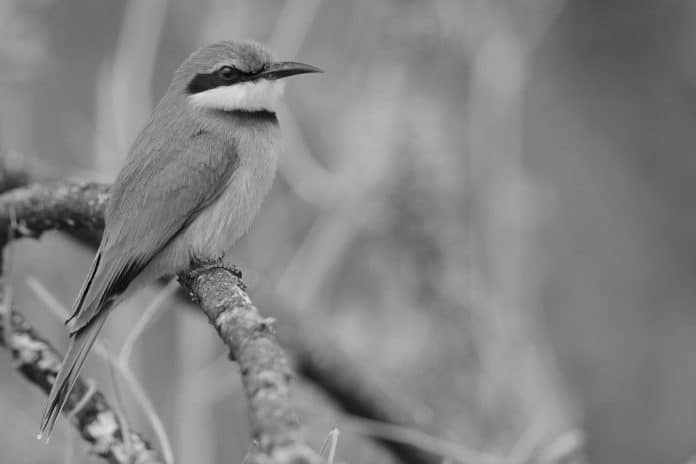Introduction to the Little Bee-Eater
Welcome to the enchanting world of the little bee-eater in Tanzania, a delightful bird species that captivates all who encounter it. Found in the picturesque grasslands of Tanzania, the little bee-eater is a small but remarkable creature known for its vibrant plumage and captivating aerial displays. As you delve into the fascinating world of this charming bird, you will gain insights into its habitat, behavior, feeding habits, and cultural significance in Tanzanian folklore. Join us on a journey through the Tanzanian grasslands as we explore the captivating presence of the little bee-eater.
Habitat and Distribution of the Little Bee-Eater in Tanzanian Grasslands

The little bee-eater is a native resident of the Tanzanian grasslands, where it thrives in a variety of habitats ranging from savannas and woodlands to riverbanks and open country. With its preference for areas with scattered trees and shrubs, the little bee-eater can be found across the country, from the Serengeti plains to the Tarangire National Park. Its widespread distribution in Tanzania makes it a sought-after species for birdwatchers and nature enthusiasts seeking to witness its vibrant presence in the wild.
The grasslands of Tanzania provide an ideal environment for the little bee-eater, offering an abundance of insect prey and nesting sites. The bird’s adaptability to these diverse landscapes underscores its resilience and ability to coexist harmoniously with the surrounding ecosystem. Whether perched on a branch overlooking the grassy plains or darting through the air in pursuit of insects, the little bee-eater’s presence adds a touch of vibrancy to the Tanzanian grasslands.
Physical Characteristics and Behavior of the Little Bee-Eater
The little bee-eater’s striking appearance makes it a standout feature of the Tanzanian grasslands. With its emerald green plumage, chestnut crown, and yellow throat, the bird’s colorful display is a sight to behold. Its slender, elongated body and distinctive black mask further contribute to its unique charm, making it a favorite subject for photographers and birdwatchers alike.
In addition to its physical attributes, the little bee-eater is known for its agile and acrobatic flight patterns. It can be observed darting through the air with remarkable speed and precision, skillfully capturing flying insects in mid-flight. These aerial displays showcase the bird’s remarkable agility and hunting prowess, adding to its allure as a charismatic species in the Tanzanian grasslands.
The little bee-eater’s social behavior is also a notable aspect of its presence in the grasslands. Often observed in small flocks or pairs, these birds engage in communal roosting and cooperative breeding, fostering a sense of unity and companionship within their groups. Their melodic calls and chirping sounds further contribute to the lively ambiance of the grasslands, creating a symphony of natural sounds that resonates throughout the Tanzanian landscape.
Feeding Habits and Diet of the Little Bee-Eater
A significant aspect of the little bee-eater’s presence in the Tanzanian grasslands is its role as a skilled insect hunter. With a diet primarily consisting of bees, wasps, and other flying insects, the bird plays a vital ecological role in regulating insect populations within its habitat. Its agile flight and precise aerial maneuvers enable it to capture prey with remarkable efficiency, showcasing the bird’s adept hunting abilities.
The little bee-eater’s feeding habits are not only essential for its own sustenance but also contribute to the delicate balance of the grassland ecosystem. By preying on insects that may otherwise proliferate unchecked, the bird helps maintain ecological equilibrium, supporting the overall health of the Tanzanian grasslands. Its foraging activities are a testament to its vital role as a natural predator, embodying the intricate interconnectedness of species within the grassland environment.
As you observe the little bee-eater in its natural habitat, take note of its foraging behavior and feeding routines, offering a glimpse into the bird’s daily activities and its integral place within the Tanzanian grasslands.
Breeding and Nesting Behavior of the Little Bee-Eater in Tanzania
The breeding and nesting behavior of the little bee-eater is a captivating aspect of its presence in the Tanzanian grasslands. During the breeding season, which typically occurs from September to October, these charismatic birds engage in intricate courtship displays, marked by aerial acrobatics and vocalizations that signal their readiness to mate. The courtship rituals of the little bee-eater are a testament to the bird’s commitment to ensuring successful reproduction within its habitat.
Nesting is a critical phase in the little bee-eater’s life cycle, as the birds meticulously excavate burrows in sandy banks or termite mounds to create secure nesting sites. The construction of these nesting chambers requires careful excavation and maintenance, showcasing the bird’s dedication to providing a safe and nurturing environment for its offspring. Once the nesting sites are established, the birds engage in cooperative breeding, with both parents taking on active roles in incubating the eggs and caring for the hatchlings.
Witnessing the nesting behavior of the little bee-eater in the Tanzanian grasslands offers a rare opportunity to observe the intricate dynamics of avian reproduction and parental care. As you explore the grasslands, keep an eye out for these nesting sites, where the industrious activities of the little bee-eaters unfold against the backdrop of the natural landscape.
Conservation Status and Efforts to Protect the Little Bee-Eater

Despite its widespread presence in the Tanzanian grasslands, the little bee-eater faces conservation challenges that warrant attention and proactive measures to ensure its continued survival. As human activities and environmental changes impact its habitat, the bird’s population is susceptible to potential threats, underscoring the importance of conservation efforts aimed at safeguarding its existence in the wild.
Conservation initiatives focused on preserving the grassland habitats and promoting sustainable practices are essential for protecting the little bee-eater and its fellow avian species. By raising awareness about the value of these ecosystems and the biodiversity they support, conservation organizations and local communities can work together to mitigate the impact of human-induced pressures on the grasslands, ultimately benefiting the little bee-eater and the entire ecological community.
As a visitor to the Tanzanian grasslands, you can contribute to conservation efforts by supporting ecotourism initiatives, adhering to responsible travel practices, and advocating for the protection of natural habitats. Your active involvement in promoting conservation awareness can help safeguard the little bee-eater’s habitat and ensure a sustainable future for this captivating species in the Tanzanian grasslands.
Best Places for Birdwatching and Spotting Little Bee-Eaters in Tanzanian Grasslands
For avid birdwatchers and nature enthusiasts, the Tanzanian grasslands offer an array of prime locations for spotting and observing the little bee-eater in its natural habitat. From the expansive plains of the Serengeti to the lush woodlands of Tarangire National Park, these iconic landscapes provide ideal settings for encountering the vibrant presence of the little bee-eater amidst the rich tapestry of wildlife.
The banks of rivers and waterholes within the grasslands serve as favored feeding and nesting sites for the little bee-eater, presenting opportune locations for birdwatching and photography. As you explore these natural settings, keep a keen eye on the surrounding vegetation and open spaces, where the little bee-eater’s distinctive colors and aerial displays make it a standout feature of the grassland scenery.
Engaging in guided birdwatching excursions and nature walks with experienced local guides can enhance your chances of encountering these captivating birds in the wild. Their intimate knowledge of the landscape and its avian inhabitants can lead to memorable encounters with the little bee-eater, offering insights into its behavior and ecological significance within the Tanzanian grasslands.
Tips for Capturing Stunning Photographs of Little Bee-Eaters
Capturing the vibrant presence of little bee-eaters through photography is a rewarding endeavor that allows you to preserve and share the beauty of these avian marvels. Whether you are an amateur photographer or a seasoned professional, employing certain techniques and approaches can enhance your ability to capture stunning images of the little bee-eater in its natural environment.
When photographing little bee-eaters, patience and attentiveness are key virtues. Position yourself in strategic locations where the birds frequent, such as perches near nesting sites or favored foraging grounds. By observing their behavior and flight patterns, you can anticipate moments of action and capture dynamic images that convey the bird’s energy and grace in flight.
Utilizing telephoto lenses and fast shutter speeds can help freeze the little bee-eater’s swift movements and vibrant plumage, allowing you to capture intricate details and vibrant colors in your photographs. Consider experimenting with different angles and compositions to showcase the bird’s natural surroundings and unique characteristics, creating compelling visual narratives that celebrate the little bee-eater’s presence in the Tanzanian grasslands.
Cultural Significance and Folklore Surrounding the Little Bee-Eater in Tanzania

In addition to its ecological importance, the little bee-eater holds cultural significance within Tanzanian folklore, where it is revered for its symbolic associations and mythical narratives. Across various indigenous traditions, the bird is often depicted as a symbol of agility, grace, and adaptability, embodying qualities that resonate with the cultural heritage of the local communities.
The vibrant plumage and aerial prowess of the little bee-eater have inspired artistic representations and symbolic interpretations within Tanzanian folklore, where the bird is celebrated as a source of inspiration and admiration. Its presence in traditional stories and narratives reflects its enduring influence as a revered creature that embodies the spirit of the grasslands and the natural world.
By delving into the cultural significance of the little bee-eater, visitors to the Tanzanian grasslands can gain a deeper appreciation for the bird’s multifaceted role in the cultural tapestry of the region. Engaging with local communities and cultural interpreters offers opportunities to learn about the bird’s symbolic significance and its enduring place within the rich heritage of Tanzanian folklore.
Conclusion
The little bee-eater’s presence in the Tanzanian grasslands is a testament to the captivating allure of nature’s smallest marvels. From its vibrant plumage and agile flight to its vital role in the grassland ecosystem, the bird embodies a spirit of resilience and charm that resonates throughout its habitat. As you embark on your journey through the Tanzanian grasslands, take time to immerse yourself in the enchanting world of the little bee-eater, where its small size belies its big presence and enduring impact on the natural landscape.

































